Summary
Divergences persist: US resilience vs China weakness
The current asymmetric risk/return profile doesn’t call for increasing risks. Instead, investors should stay balanced and search for signals regarding confirmation of the economic direction.
August was a month when risk assets, after giving back some of their gains, closed flat, whereas yields on 10Y USTs reached 15-year highs. On the one hand, the US displayed economic resilience on the back of fiscal incentives and business investment. However, sentiment was affected by slowing momentum in China, regarding which we downgraded our 2023 growth forecasts from 5.1% to 4.9%.
Importantly, forward-looking indicators in the US and Europe point to an imminent deceleration. All this creates low visibility moving into autumn and we see the following factors shaping the global economy:
- Although we revised up our 2023 US growth forecasts from 1.6% to 2.1%, we still think that a (mild) recession from Q1 is possible, due to the lagged effect of tightening financial conditions and dwindling excess savings. However, business investments could present a challenge to our decelerating consumption scenario.
- Terminal rates and inflation dynamics. We see upside risks to our 5.5% rate forecasts for the Fed. More clarity on the direction of services and core inflation is needed to confirm a downward path.
- Lackluster European growth. Recession could be averted at a regional level this year, but divergences across countries are likely: restrictive policy, diminishing fiscal support, waning demand.
- China is moving to a slower, sustainable growth model, given the government’s willingness to accept near-term pain for better growth quality long term. This would affect Europe and other EM.
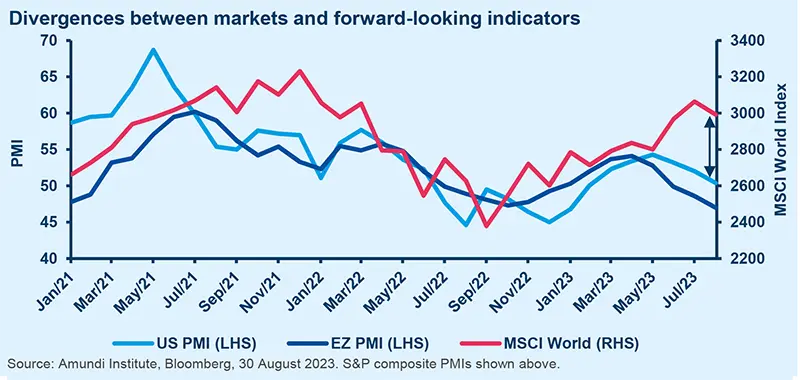
Investors may explore these asset classes, with a vigilant approach:
- Cross asset. Uncertainty on earnings and the economic backdrop still calls for a cautious stance on US and European equities, but we are positive on EM. In FI, the move up in yields keeps us positive on US duration, with some protection, but we are defensive on US HY amid tight valuations. However, we like select EM local debt and are slightly more positive on Brazilian rates after the recent rate cut there. This could also act as a diversifier regarding our constructive views on BRL/USD FX, on which we are more positive now. Overall, we think there is a need to maintain hedges on equities and a positive stance on gold, while accepting the limited upside on the metal.
- Fixed income. There are changing liquidity dynamics at play, with limited support from the Fed moving from QE to slow QT at a time when government bond issuance is high. This supply/demand mismatch is affecting markets as yields oscillate between news on economic activity, CB policies and government debt. We stay active on duration, with a slightly positive view on the US and a close to neutral/slightly cautious stance on Europe. In credit, we are defensive on HY, but differentiate between high and low quality. Instead, we like IG names that have sufficient capital cushions and cash flows.
- US and EU equities still show high valuations despite the recent pullback. The risk profile is asymmetric, as upside is limited now, given that most of the good news (soft landing) is already priced in. If our scenario of a mild recession plays out, this could be negative for equities, especially US large caps, growth and tech. On the other hand, we like segments and businesses where the upside is driven more by earnings growth and less by multiples expansion. We like value and quality sides of the market, but maintain a selective lens.
- EM offer opportunities, particularly in LatAm, Asia. While there are areas that would be affected by China’s slowdown, we emphasise the importance of looking at countries such as Brazil, India, Indonesia. HC debt offers high carry and we see scope for a rebound in HY. We also like LC debt and keep a positive view on LatAm exporters. However, we are moving to neutral on Chinese equities, but like India and are more positive on Brazil. Overall, bottom-up focus is important.
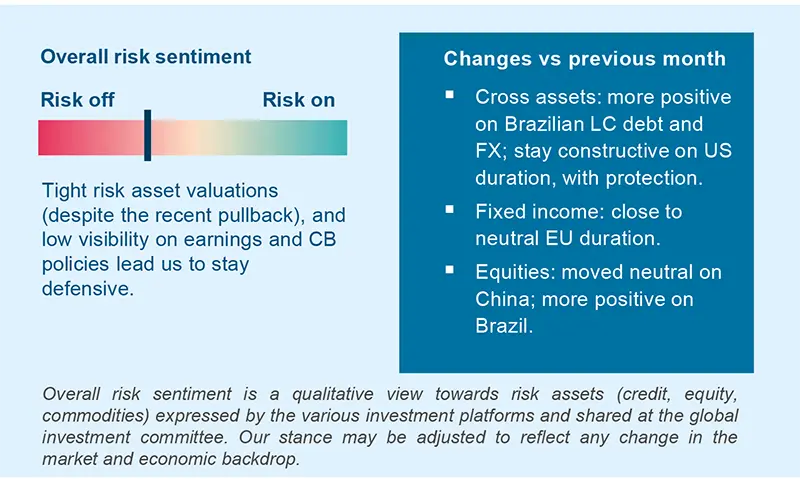
Three hot questions
|
Monica DEFEND |
The downgrade of Chinese economic growth, risks around US recession, and sluggish growth in Europe will further mean that the ECB and the Fed will remain data-dependent in their efforts to weed out the last leg of inflation.
1| US growth has surprised to the upside so far this year. Do you think this will continue, and what about Europe?
We upgraded US economic growth forecasts for this year from 1.6% to 2.1% as fiscal incentives are playing in favour of stronger investments in select categories. However, we still expect a recession from Q1 next year, with Q4 2023 showing a slowdown. In the Euro Area, recession risks have increased, and we see a weak quarterly growth pattern for H2 2023 and moving into 2024. The region should avoid a recession, but this cannot be said for individual countries.
Investment consequences:
- Slightly positive/close to neutral on USTs; neutral on Euro rates.
- Cautious on US high yield.
2| How do you see Chinese economic activity evolving this year and beyond?
While we marginally downgraded our forecasts for Chinese economic growth this year, more importantly, we lowered our 2024-25 numbers from 4.7% and 3.9%, to 3.7% and 3.4% respectively. This reflects a more rapid economic transition towards lower, more sustainable growth. On top of the construction slowdown, the services sector deceleration is concerning. In addition, the pain threshold for policymakers has become vague, and it does not seem that 3-4% growth will trigger more substantial responses.
Investment consequences:
- Chinese equities: Lowered to neutral.
- Oil: Brent prices anchored around an $85-90/bbl target.
3| What are the key takeaways from the latest earnings season?
EPS growth was negative in Q2, but it was better than expected, both in the US (-3.4% vs -5.7%, YoY, expected in early July) and the EU (-5% vs -7.4%). The US fared slightly better compared to Europe, the first time in this cycle, partly supported by the economic backdrop and a weaker dollar, which increases international earnings of US companies. In fact, excluding the energy sector, US EPS growth was positive at 3% and consumer discretionary was the biggest surprise, with earnings growing at 53.6%.
Investment consequences:
- Prefer Japanese equities over US (priced for perfection).
- In Europe, we are neutral; sector-wise, we stay balanced between cyclicals and defensives.
Look for diversified opportunities in EM bonds
|
Francesco SANDRINI |
John O'TOOLE |
While it’s not time to add risk, investors can look for income opportunities in the EM bond space.
We have seen three main themes of late. First, the US economy has been resilient on the back of strong investments and consumption. But China, on track for lower long-term growth, is showing signs of weakness in its near-term trajectory. Thirdly, the policy divergence between EM and DM CBs is becoming more visible after the recent rate cuts in LatAm. This backdrop calls for a cautious, diversified stance with all portfolio hedges in place. However, investors should aim to benefit from the EM growth advantage and policy divergences through EM equities and debt.
High conviction ideas
DM equity valuations remain expensive even as earnings have trended lower. For any rebound to be sustainable, it must be matched with earnings growth, which remains uncertain. We think earnings may continue to face headwinds well into 2024, underscoring our cautious DM stance. On the other hand, we stay slightly positive on EM and are vigilant on Chinese growth and its potential effects on other countries with strong trade ties.
We are constructive on US duration, with some scope for protection on 10Ys amid strong economic data, excess supply of US debt, and concerns about a relatively hawkish Fed. We also believe in the bull steepening of the US and Canadian curves. In Europe, valuations are in favour of a slightly positive stance on duration as macro data are weak and less supportive of the hawkish camp in the ECB. Similarly, Swedish bonds should gain from a vulnerable domestic economy and Italian BTP-Bund spreads from supportive technicals. At the other end, we are active across global yield curves and think UK 10Ys are likely to outperform Australian 10Ys. However, we are cautious on JGBs.
In EM, we are constructive on bonds and turned marginally more positive on Brazil amid our expectations of CB rate cuts. We are also optimistic on Czech government bonds (hedged).
In DM, credit, fundamentals are mixed and spreads are tight in US HY, not in line with tight financial conditions that could affect liquidity and the ability of companies to raise capital going forward. Thus, we stay defensive.
With regard to FX, we raised our positive view on the BRL/USD due to Brazil’s declining political risk and stay positive on the MEX/EUR and INR/CNH. In DM, we are negative on the GBP but positive on the JPY (vs EUR and CHF) amid its safe-haven qualities. The USD should weaken as the Fed slows its rate hikes.
Risks & hedging
We think investors should maintain portfolio protections on risk assets due to low visibility on earnings and the economic outlook. At the other end, gold continues to offer diversification and protection against recession and geopolitical crisis. But we acknowledge the limited upside in the near term due to tighter valuations and the recent move up in real yields.
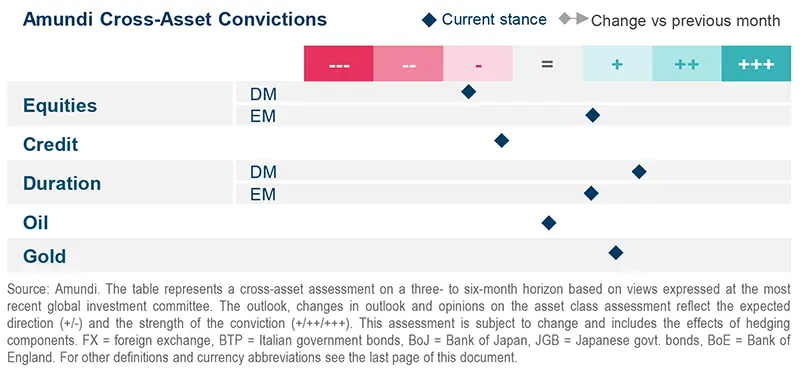
Bonds in focus: IG credit financials are favoured
| Amaury D'ORSAY Head of Fixed Income |
Yerlan SYZDYKOV Global Head of Emerging Markets |
Kenneth J. TAUBES CIO of US Investment Management |
In credit we favour IG, as valuations in HY do not fully compensate investors for the risks around economic slowdown and tightening conditions.
Overall assessment
Sticky core inflation is above CB comfort levels, even as clouds on economic growth remain. This creates policy uncertainty and calls for a flexible stance on duration in government bonds, along with a tilt towards quality in DM and EM credit, given our expectations for an economic slowdown.
Global & European fixed income
The ECB is unwilling to give up its fight on inflation so soon and will remain data-dependent to maintain the option of keeping rates restrictive. This approach keeps us active and tactical on duration and for now we are slightly cautious/close to neutral overall: marginally cautious on core Europe and significantly defensive on Japan. On the other hand, we are positive on Italian BTPs, but overall neutral on European peripheral debt. Lacklustre growth expectations in EZ and the effects of a slowing recovery in China lead us to keep our cautious tilt on low-quality HY corporate credit. However, we like IG and subordinated debt and from a sector perspective, our preference is for financials. We think fundamentals are strong in financials: we like banks that have strong asset liability management and benefit from a higher interest rate environment.
US fixed income
Recent yield movements create a positive backdrop for duration management and we stay slightly constructive amid our concerns on slowing economic activity. But we now see more value in the intermediate part of the UST curve. In securitised credit, we believe the mortgage market is sound, as a confluence of factors (demographics, low housing supply, etc) is making house prices sticky. Some cracks could emerge in consumer demand if labour markets loosen up. The resumption of student loan payments and depletion of excess consumer savings could weigh on consumption. Hence, we stay active in MBS and are monitoring rate volatility and technical aspects, such as quantitative tightening. In corporate credit, we are selective and cautious on valuations, particularly HY. Overall, we prefer IG over HY and financials over non-financials.
EM bonds
The EM debt outlook is shaped by slowing inflation, robust EM growth, and ever-increasing divergences. While we are vigilant on the dollar, we maintain our constructive view on LC debt but are selective and favour LatAm countries such as Brazil, Mexico and Chile. In China, we are cautious, especially on the real estate sector, and at this stage, we do not expect significant policy support. We also like HC debt owing to robust capture carry but favour HY over IG.
FX
Even though the USD recovered some lost ground, from a cyclical perspective, the medium-term path indicates a weaker dollar. We are positive on EM FX and especially like the INR, IDR and high-yielding LatAm FX such as the MXN and BRL.
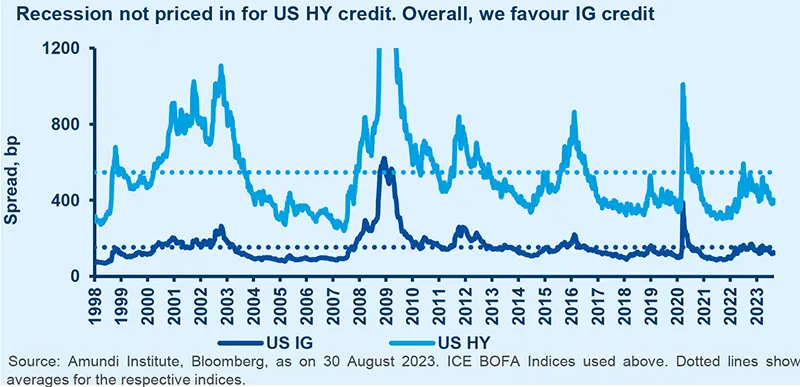
Look for earnings quality, balance sheet strength
| Fabio DI GIANSANTE Head of Large Cap Equity |
Yerlan SYZDYKOV Global Head of Emerging Markets |
Kenneth J. TAUBES CIO of US Investment Management |
Current earnings estimates look too optimistic, but this could change as markets feel the pressures from an economic slowdown.
Overall assessment
If recession in the US plays out as feared, both earnings and margins would come under pressure not only in the US but also in Europe, given that the region is a more open economy. On the other hand, valuations in some pockets are expensive vs others, making this an attractive market for selection. We explore quality (intellectual property, pricing power, product differentiation, etc) and value businesses in DM and EM (Latin America, Asia).
European equities
Valuations were high as we entered the Q2 earnings season, so we paid particular attention to management communication. We expect managements to be more cautious in their messaging now, in line with cautious soft data. In the latest earnings, banks’ results exceeded expectations as they benefitted from higher interest rates. However, areas such as consumer-exposed sectors suffered. Nonetheless, we maintain our barbell approach, with a focus on defensive (consumer staples that are structural winners) and cyclical names, such as financials/retail banks, owing to their robust balance sheets. In addition, construction-related companies delivered strong performances and investors should consider locking in the performance. Unsurprisingly, there are sectors such as tech that are more expensive and we are cautious on them.
US equities
The fiscal boost from the government has helped consumers, but we think excess savings could dissipate. Markets, which are priced for perfection, don’t reflect that. While we remain cautious on large caps/growth, we prefer defensive, quality and value trading at reasonable valuations. We also notice that intra-stock correlations have fallen and that is positive for selection. At the sector level, we like large cap banks that have strong capital cushions. This is all the more important after the recent downgrades. Interestingly, the new capital rules being discussed for the sector and recession/credit risks make it less obvious to own banks than before, but we focus on businesses with stable deposit bases and that are technology leaders. Furthermore, we favour energy, materials and life science tools. We also note that pockets of pharma, medical technology, and consumer retail are becoming interesting, although we remain vigilant regarding weakening labour markets.
EM equities
EM are characterised by attractive valuations and expectations for earnings recovery, but slowing growth in China and US requires us to be selective. We like Brazil (more than before) and India. Brazil has started monetary easing and economic growth is also being boosted by agriculture, while India continues to be a beneficiary of supply chain alterations and internal policies are spurring growth. In China, sentiment has turned pessimistic, especially in real estate and discretionary, due to structural challenges, leading us to be tactically neutral.

Amundi Asset Class Views
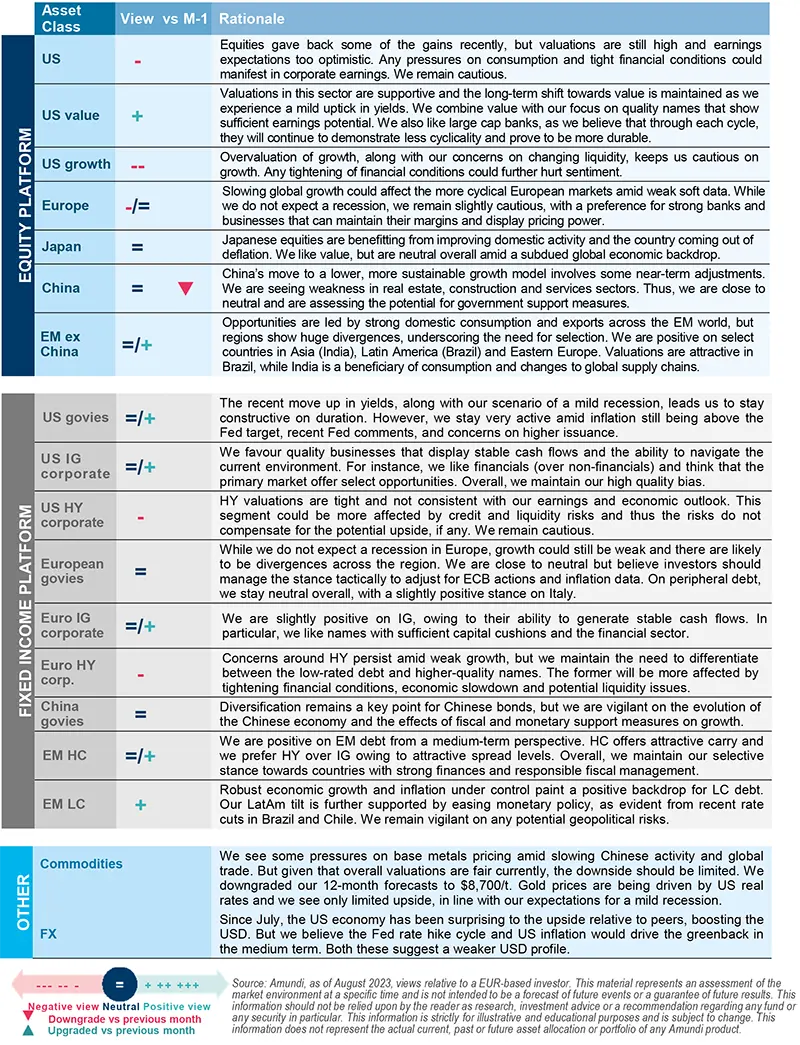
Definitions & Abbreviations
- ABS: Asset-backed securities. These are financial securities such as bonds, which are collateralised by a pool of assets, possibly including loans, leases, credit card debt, royalties or receivables.
- Agency mortgage-backed security: Agency MBS are created by one of three agencies: Government National Mortgage Association, Federal National Mortgage and Federal Home Loan Mortgage Corp. Securities issued by any of these three agencies are referred to as agency MBS. Beta: Beta is a risk measure related to market volatility, with 1 being equal to market volatility and less than 1 being less volatile than the market.
- Breakeven inflation: The difference between the nominal yield on a fixed-rate investment and the real yield on an inflation-linked investment of similar maturity and credit quality.
- Carry: Carry is the return of holding a bond to maturity by earning yield versus holding cash. Core + is synonymous with ‘growth and income’ in the stock market and is associated with a low-to-moderate risk profile. Core strategy is synonymous with ‘income’ in the stock market.
- Correlation: The degree of association between two or more variables; in finance, it is the degree to which assets or asset class prices have moved in relation to each other. Correlation is expressed by a correlation coefficient that ranges from -1 (always move in opposite direction) through 0 (absolutely independent) to 1 (always move in the same direction). Credit spread: The differential between the yield on a credit bond and the Treasury yield. The option-adjusted spread is a measure of the spread adjusted to take into consideration the possible embedded options.
- Currency abbreviations: USD – US dollar, BRL – Brazilian real, JPY – Japanese yen, GBP – British pound sterling, EUR – Euro, CAD – Canadian dollar, SEK – Swedish krona, NOK – Norwegian krone, CHF – Swiss Franc, NZD – New Zealand dollar, AUD – Australian dollar, CNY – Chinese Renminbi, CLP – Chilean Peso, MXN – Mexican Peso, IDR – Indonesian Rupiah, RUB – Russian Ruble, ZAR – South African Rand, TRY – Turkish lira, KRW – South Korean Won, THB – Thai Baht, HUF – Hungarian Forint.
- Curve steepening: A steepening yield curve may be a result of long-term interest rates rising more than shortterm interest rates or short-term rates dropping more than long-term rates.
- Bull steepening: a change in the curve due to short-term rates falling faster than the long-term rates. This leads to a higher spread between the short and long term rates.
- Curve inversion: When long-term interest rates drop below short-term rates, indicating that investors are moving money away from short-term bonds.
- Cyclical vs. defensive sectors: Cyclical companies are companies whose profit and stock prices are highly correlated with economic fluctuations. Defensive stocks, on the contrary, are less correlated to economic cycles. MSCI GICS cyclical sectors are: consumer discretionary, financial, real estate, industrials, information technology and materials. Defensive sectors are: consumer staples, energy, healthcare, telecommunications services and utilities.
- Duration: A measure of the sensitivity of the price (the value of principal) of a fixed income investment to a change in interest rates, expressed as a number of years. High growth stocks: A high growth stock is anticipated to grow at a rate significantly above the average growth for the market. Liquidity: The capacity to buy or sell assets quickly enough to prevent or minimise a loss. P/E ratio: The price-to-earnings ratio (P/E ratio) is the ratio for valuing a company that measures its current share price relative to its per-share earnings (EPS).
- Net interest margin: It is a measure that compares a bank’s interest income from lending with its interest expense on its liabilities (such as bank deposits), expressed as a percentage of its assets.
- QE: Quantitative easing (QE) is a type of monetary policy used by central banks to stimulate the economy by buying financial assets from commercial banks and other financial institutions.
- Quality investing: This means to capture the performance of quality growth stocks by identifying stocks with: 1) A high return on equity (ROE); 2) Stable year-over-year earnings growth; and 3) Low financial leverage.
- Quantitative tightening (QT): The opposite of QE, QT is a contractionary monetary policy aimed to decrease the liquidity in the economy. It simply means that a CB reduces the pace of reinvestment of proceeds from maturing government bonds. It also means that the CB may increase interest rates as a tool to curb money supply.
- Non-SIFI: A systemically important financial institution (SIFI) is an institution that the US Fed and regulators believe would pose a serious risk to the financial system and the economy if it collapses. A non-SIFI is an institution that doesn’t fall in this category.
- RMBS: Residential mortgage-backed securities (RMBS) are a debt-based security backed by the interest paid on loans for residences. The risk is mitigated by pooling many such loans to minimise the risk of an individual default.
- TIPS: A Treasury Inflation-Protected Security is a Treasury bond that is indexed to an inflationary gauge to protect investors from a decline in the purchasing power of their money.
- Value style: This refers to purchasing stocks at relatively low prices, as indicated by low price-to-earnings, price-to-book and price-to-sales ratios, and high dividend yields. Sectors with a dominance of value style: energy, financials, telecom, utilities, real estate.
- Volatility: A statistical measure of the dispersion of returns for a given security or market index. Usually, the higher the volatility, the riskier the security/market.
- Yield curve control: YCC involves targeting a longer-term interest rate by a central bank, then buying or selling as many bonds as necessary to hit that rate target.




